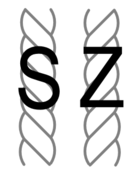
ISO 2
Encyclopedia

International standard
International standards are standards developed by international standards organizations. International standards are available for consideration and use, worldwide...
for direction of twist designation for yarn
Yarn
Yarn is a long continuous length of interlocked fibres, suitable for use in the production of textiles, sewing, crocheting, knitting, weaving, embroidery and ropemaking. Thread is a type of yarn intended for sewing by hand or machine. Modern manufactured sewing threads may be finished with wax or...
s, complex yarns, slivers
Sliver (textiles)
A sliver is a long bundle of fibre that is generally used to spin yarn. A sliver is created by carding or combing the fibre, which is then drawn into long strips where the fibre is parallel. When sliver is drawn further and given a slight twist, it becomes roving....
, slubbings, roving
Roving
A roving is a long and narrow bundle of fibre. It is usually used to spin woollen yarn. A roving can be created by carding the fibre, and it is then drawn into long strips. Because it is carded, the fibres are not parallel, though drawing it into strips may line the fibres up a bit...
s, cordage, and related products. The standard uses capital letters S and Z to indicate the direction of twist. The convention of using these two letters to unambiguously designate twist direction was already used in the cordage industry by 1957.
External links
- ISO 2:1973 Textiles — Designation of the direction of twist in yarns and related products

